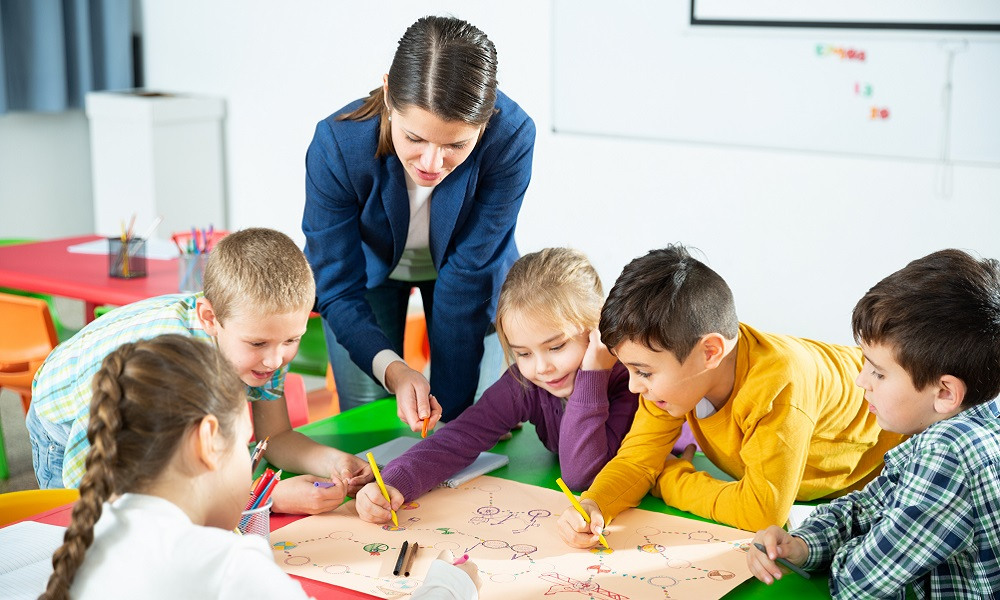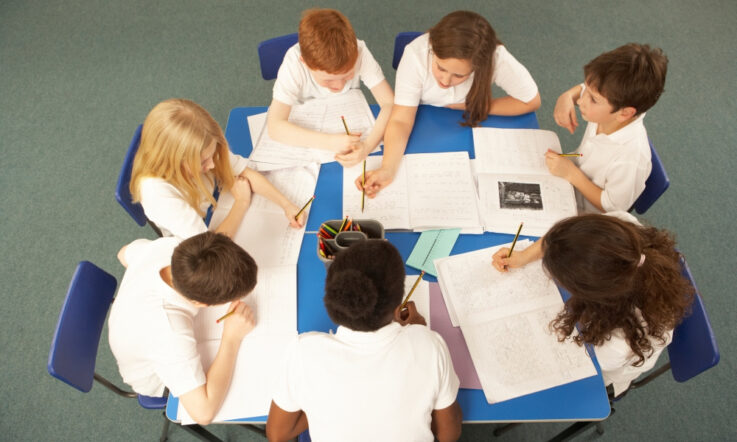From Teacher magazine, I'm Rebecca Vukovic and you're listening to an episode of The Research Files.
Which is more creative, the Arts or the sciences? My guest, Professor David Cropley from the University of South Australia, joins me today to discuss this question and to delve into his research into whether any specific differences exist between creativity in the Arts and creativity in STEM. David is an internationally recognised expert on creativity and innovation. He's appeared on several television programs on the ABC, including Redesign My Brain and Life at 9. The study we're focusing on today was co-authored by Kim van Broekhoven and Phillip Seegers from Maastricht University in the Netherlands. The study surveyed over 2000 German undergraduate students enrolled in STEM courses and in Arts courses, to explore how creativity differed across the disciplines. In this episode, David takes me through how they conducted the study, some of the key findings, and the practical implications of this research for educators working in the K-12 space. Let's get started.
Rebecca Vukovic: Professor David Cropley, thanks for joining Teacher magazine.
David Cropley: Hi Rebecca, it's great to be with you this morning.
RV: Let's begin by talking about your research that explores the nature of creativity and whether differences exist between creativity in the sciences and creativity in the Arts. Who was involved in this study?
DC: Well this particular study was a very large sample of German university students. They were primarily students in the STEM disciplines but also with a subset of Arts students. So university students from Germany, mainly STEM but also some Arts students.
RV: Okay, how did you go about conducting the study?
DC: It's quite interesting. The two co-authors in the study, Kim and Phillip, are both graduate students at Maastricht University in Holland and Phillip in particular also works for an organisation in Germany that regularly collects data from university students about all sorts of things like job experiences and various other aspects of their studies. But from time to time, when they do this, they can also insert other questions when they do these rounds of data collection. And so they were able to organise, Kim and Phillip were able to organise doing a block of questions about creativity, so it opened up an opportunity for us and with a very large sample of students.
RV: What was the motivation for asking these questions and conducting the research in the first place?
DC: Well there is a very longstanding debate in creativity research about whether it's, they use the terms ‘domain general' or ‘domain specific'? So basically, is creativity something that is different in every discipline or every area of activity, or are there things that are common across the board? Or is it some mix of those things? And of course, that's there it becomes very important for schools and for education because if creativity is basically subject specific, then that will affect how we teach it. On the other hand, if creativity is domain general, if it's general across the board then that will also have an influence on the way it's taught. And, if it's some sort of interesting mix of the two, again, we need to understand that if we're going to build this thing we call ‘creativity' into primary, secondary and tertiary education.
RV: And so then, what were some of the key findings to come from the study?
DC: I think there are at least a couple of things. One, the very important one, was not that we discovered that it was general or specific, but this particular study confirmed what I would say is the general view in creativity that some things are specific to the subjects and to areas, and some things are general. So in this particular study we basically confirmed that the way we think when we're engaging in creativity seems to be largely a general skill if you like, and also the personal qualities that help a person to be creative, whether they're open to new ideas or whether they're willing to take risks, those things are also general in nature.
But we also found that the way people view creativity, the way you, if you look at an artifact or a product and what makes you decide whether or not that's creative, that is more subject specific or domain specific. So we found this confirming what we think we already knew which is that it's a mixture of some things are specific and some things are general.
RV: We've spoken about why you did the research and you've just covered some of the key findings there. But I'm wondering, in what ways does this study contribute to the body of research that already exists in the area of creativity?
DC: Well as I said, basically it's really confirming what a lot of other research has already shown but with two important differences or two important added features. And I think the first of those is that this was a very large study, so we had in excess of 2000 participants. And that's important because the larger the study, the more we can begin to generalise the results from that group that we studied to the wider community. So, compared to a lot of creativity studies, this one was very large, which makes it more generalisable. And also the other interesting feature about this was the focus on STEM. So a lot of creativity research, we often see general samples of people, so just school kids in general or students at university or just people in general, and the ability here to really focus primarily on people studying STEM also made it kind of unique. So it confirmed a lot of what we already knew but it confirmed it in a particularly interesting sample.
RV: And as you mentioned there, this particular study focused on undergraduate students at university. But our focus here at Teacher magazine is on teachers and school leaders in K-12. What are some of the practical implications of this research for those teachers working in the K-12 space?
DC: I think where it's very important and interesting for school teachers and leaders in the K-12 space is that it builds up this picture of the progression of creativity from Reception or Kindergarten, right through to university. And what I think it really helps us to see and this will influence how we respond to creativity in education, is that we kind of move from creativity being quite general for younger children because of course they're not yet specialising in anything, and as they move through high school they begin to specialise in subjects and particular areas, and as they move on to university that specialisation continues.
And so education is moving across a continuum from general to specific and the more we know about creativity in similar terms of what's general and what's specific, puts us in a better position to really understand how to create a unified approach to creativity across all levels of education so that we're not just flying blind and saying, ‘let's teach them a bit of this and that' and hope that it works. This research is helping to contribute to creating a very holistic and unified approach to creativity across education, and I think also helps teachers to understand further what it is that we're trying to do with creativity and how we need to respond to that in the education system.
RV: And David I'd like to pick up on that – that holistic approach. I'm wondering, what does a holistic approach actually look like in the classroom?
DC: Well it's also a very important question. In very simple terms, I like to think that it means it's not piecemeal. It means, I sometimes use simple examples like – we're not going to teach children to be creative in a broad sense of being problem solvers and dealing with uncertainty and so on, if we treat creativity as something that you do 40 minutes of, every second Friday, at the end of the school week. We've got to take this integrated, holistic approach and understand that creativity has to be embedded across the curriculum. So it's not a separate subject in its own right, it's something that has to be sprinkled across every other subject.
And that's important in terms of creating this holistic approach, understanding that creativity is an enabler of other subjects and it has to be embedded in all those other subjects. And the more that we understand that when you're doing that in primary school, it has a certain sort of characteristic that's more general, but as we move into high school, that we really have to understand how do we embed creativity in physics classes and how do we embed it in drama or music and there are some commonalities but also what are the subtle differences? So across the board, the holistic approach, in very simple terms, is creativity is not a little subject in its own right, it has got to be embedded in a very sort of systematic way across everything that we do at school.
RV: And David that leads well into my next question, but before I ask that question, I'd like to read a quote from the research that I found really interesting. It says, ‘These results support the notion that creativity, as a manifestation of who we are, and how we think, is general in nature. People who are open, flexible and adept at thinking divergently are best placed to be creative, and education systems at all levels should foster those qualities.' So then, how can education systems and schools foster students' creative capabilities?
DC: Well in addition to what I said about treating creativity as something that's spread across the curriculum, spread across everything that we do at school, a more concrete way to answer that question about fostering these creative capabilities is to think of creativity as a habit. One way I like to think of it is – you don't learn to play the piano by reading a book about playing the piano, you've got to experience playing the piano and that means you've got to have the opportunity to sit down at a keyboard and actually press on the keys. And you also then have to get feedback and encouragement.
And there are three things when we think of creativity as a habit, there are three things that are necessary that I just mentioned – opportunity, encouragement and reward. So as we embed creativity across the curriculum, if we take that concept of creativity as a habit, as a kind of guiding principle, and the need for the opportunity to be creative across different subjects, and then when children in the classroom show that they're making use of those opportunities, that they get the encouragement, and when they do things that are actually creative, that they get some kind of recognition and reward – that's the essence or it's the first important step in fostering creative capabilities at the school; this idea that it's a habit, that kids need opportunity, encouragement and reward, and that it's really the job of the teachers to sort of guide that and create that. And what the teachers do in the classroom themselves, of course, is as important as what's in the curriculum. So the teachers are also constantly demonstrating what it looks like for a person to be open to new ideas and flexible and able to think divergently and so on.
RV: Yes, and David I'd like to ask you now about the work that you're currently doing in schools because I understand that you're working with three schools at the moment – one in Victoria and two in South Australia – to further embed creativity into their programs. Could you tell listeners a little more about this work?
DC: It's interesting. It's spread across different kinds of schools both in the independent sector and in the government sector. And really, what links those schools together is that they're all schools that are … education in general is increasingly recognising that creativity is something that's important. We've heard about 21st Century skills and we've heard about the fact that we want children to be able to thrive in this sort of new environment that they'll be moving into when they finish school.
The schools that I've been working with particularly, of course, all recognise that like many schools do, but they're making a particular effort to find some time in what they do in the curriculum in the school day to really try to take steps to embed creativity in their activities. They're all doing it in different ways but with the same basic goal of … I think it comes from the fact that for some of these schools, at least they're recognising that when their students leave school and go on to things like university and other forms of further education or work, that they're not always equipped with everything that they need to succeed. And these schools have been asking themselves, what is it that they're not currently getting at school that they should be that will ensure that they go out into the wider world able to deal with everything that life throws at them?
And so they've seen that creativity is at least one thing that's important there – it's important that it helps people to solve problems, to deal with ambiguity and uncertainty – and so these schools are taking steps to do what I've been describing, but as I said, they're doing it in different ways but really trying to embed this ability to be creative, and [to find] new and effective ways to solve problems and embedding that across everything that they do at the school.
RV: And creativity is something that I've noticed so many schools are talking about, and I'm aware that we will have people listening to today's episode that are interested in learning more about how to embed and assess creativity in their own school settings. So, drawing on all that we've spoken about today, I'm wondering David, have you learned any lessons from your work in schools that would be useful to share with those listeners?
DC: Yep, the first and it's very important to say some other research that I've done in the last couple of years began on the assumption that teachers don't have a particularly good understanding of creativity. However, in a very large international study with several thousand teachers from schools in Australia, North America and Europe, in fact we found a very positive picture that in fact teachers across all subjects and these different countries do have a good understanding of what creativity means and why it's important and do have a strong desire to embed creativity in what they're doing. So I think that's a very positive lesson, first of all, for creativity researchers like myself, is that teachers really do have a good and fairly sophisticated understanding of what we're talking about and that's a very good starting point for doing what we're trying to do. As more schools are thinking about this, we're working with teachers who have the motivation and the understanding to do this, so that's a very positive thing.
I think the other lesson learned, and of course it's always a challenge, is that teachers are very busy people, and people like me (creativity researchers), I constantly try to remind myself that it's no good giving people advice and so on if it doubles their workload and if it's not practically implementable. So the sorts of things I'm talking about I try to be very conscious and respectful of the fact that teachers are busy people, they've got a very challenging job already. But part of that is trying to reassure them that I'm not talking about tearing up the curriculum and starting again, but it's how can we take these ideas and concepts about creativity and just gently embed them in what the teachers are currently doing? So, with minimal changes, it's more a change in approach and thinking, rather than a change in the curriculum.
I think that's another very important lesson – that if this this is going to work and if we're all going to achieve these outcomes that I think we know we need to achieve, then it's got to be done in a way that's doable for teachers, that's practical and that understands the conditions under which teachers are working, so it's got to be sensible and practical and achievable. I think in many ways, those are the most important lessons, is that this will fail if it's just creativity researchers talking at teachers but not giving them practical tools to help them do these things, practical frameworks and being respectful of the fact that teachers already have a very crowded curriculum and a busy job.
That's all for this episode. If you loved this chat with Professor David Cropley, there are plenty of others just like this one in our archive at teachermagazine.com.au. That's also where you'll find the transcript of this episode and a link to the study we spoke about today, if you're interested in learning more about it. And finally, we'd love for you to rate or review the podcast in your podcast app, and subscribe to the channel, to ensure new episodes land in your feed as soon as they're available.
References
Patston, T. J., Cropley, D. H., Marrone, R. L., & Kaufman, J. C. (2018). Teacher implicit beliefs of creativity: Is there an arts bias?. Teaching and teacher education, 75, 366-374.
van Broekhoven, K., Cropley, D., & Seegers, P. (2020). Differences in Creativity Across Art and STEM Students: We Are More Alike than Unalike. Thinking Skills and Creativity, 100707.
David Cropley says there are three necessary things to make creativity a habit – opportunity, encouragement and reward.
How do you provide opportunities for students to be creative across different subjects? When students make use of those opportunities, what encouragement do you offer them? And, when students do things that are creative, do you give them any kind of recognition or reward?



